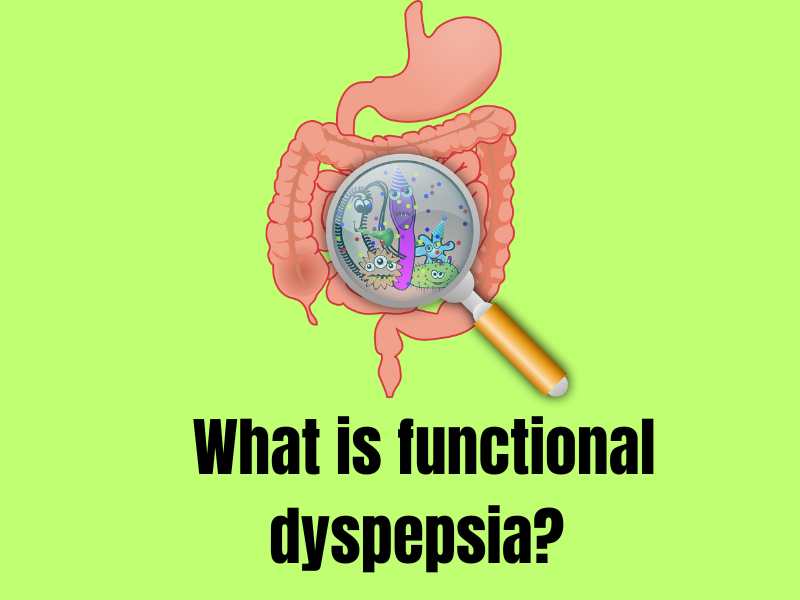 |
| What is functional dyspepsia? Causes, symptoms and treatment Functional Dyspepsia |
What is functional dyspepsia?
Dyspepsia is another word for indigestion. People with chronic indigestion often complain of abdominal pain, over-fullness, and bloating during and after eating.Other normal side effects incorporate indigestion, acid reflux, and unreasonable burping. These symptoms are similar to peptic ulcer disease, but when tested, only 1/3 of people will have stomach ulcers - the other 2/3 will have functional indigestion.
A functional disorder is an ongoing problem with your physical functions that cannot be explained by physical causes. You have symptoms, and doctors can see those symptoms, but they can't find a mechanical cause for them. Gastrointestinal diseases are often "functional" rather than structural. Doctors always do not understand why they are happening. It may involve the brain and nerves.
What are the symptoms of functional dyspepsia?
Symptoms of indigestion are sporadic: they come and go without obvious reasons, and it is difficult to tell whether something, in particular, makes them better or worse. While functional dyspepsia is chronic – running for a long time – it may disappear for a while and then return for unknown reasons. To be diagnosed, you must have had symptoms within the last three months and have continued for at least six months. You may also have more than one of the following symptoms:
Epigastric pain:- This pain occurs in the upper part of the stomach below the ribs. This area called the epigastrium, is home to your stomach, small intestine, pancreas, and liver.
Bloated stomach:- Uncomfortable pressure or feeling of fullness in your stomach, especially after eating.
Early satiety or loss of appetite:- Feeling "full" very quickly after eating.
Heartburn:- It is a burning pain in the area between the stomach and esophagus, which is usually caused by acid reflux.
Acid Reflux: Stomach acid backs up from your stomach through your esophagus, causing a burning sensation in your mouth and often a sour taste.
Nausea and vomiting:- In most cases, actual nausea of completely and lack of appetite that may cause into vomiting.
What are the different types of functional dyspepsia? Are there different types of functional dyspepsia?
Some expert reveal symptoms of functional dyspepsia into two categories:-
Epigastric pain syndrome (EPS) refers only to symptoms that are associated with pain and burning in the upper abdomen.
Postprandial misery condition (PDS) alludes just to side effects that happen in the wake of eating, like early completion, bulging, and sickness.
Not everyone's symptoms fall neatly into these two categories, but when they do, it helps health professionals treat those symptoms as a group.
How can I know whether I have functional indigestion or gastritis? functional dyspepsia vs. Gastritis?
Gastritis and indigestion share many symptoms, and you can have both. Gastritis, which is an inflammation of the stomach or back, is usually the cause be the diagnosis. It can be a bacterial infection, excessive use of certain pain medications that destroy the lining of the stomach (NSAIDs) and can cause too much acid in the stomach. These things can be examined and treated. If you have functional indigestion, it may be part of the gastritis equation, but not all. You can find and treat the cause of your gastritis and experience some relief from those symptoms, but not complete relief.
How do I know if I have functional dyspepsia vs. GERD? functional dyspepsia vs. GERD?
GERD can also be a major part of functional dyspepsia. Heartburn, belching, and a sour taste that sometimes accompanies acid reflux are among the symptoms of functional indigestion. If you have GERD, it is not difficult for healthcare providers to recognize it. Chronic acid reflux damages your digestive system over time. GERD is likewise somewhat simple to treat with prescriptions that have little stomach acid. Assuming that you have treated your GERD, however, you actually have acid reflux side effects, you might be determined to have useful dyspepsia.
How do I know if I have functional dyspepsia vs. IBS? functional dyspepsia vs. IBS?
Irritable bowel syndrome (IBS) is another functional disorder, like functional dyspepsia. They also have similar nicknames. Functional dyspepsia is called "irritable stomach syndrome" and IBS is called "tantrika stomach" (nervous stomach). However, IBS is actually related to the intestines, specifically the large intestine, and the colon. Symptoms of functional dyspepsia are more associated with the stomach and upper small intestine. FD pain is more like irritation in the upper GI tract, while IBS pain is more like intestinal cramps due to constipation or diarrhea.
What is functional indigestion? What are the causes of functional dyspepsia?
The word "indigestion" means that something is wrong in your digestive process. But this may happen a lot. Doctors do not have a clear answer about the causes of functional dyspepsia, but they do have some suggestions. Some of these include:
Impaired stomach accommodation:- Normally, the stomach should relax and expand to accommodate food, but in some people, this function may be impaired, causing a constant feeling of fullness. Signals that signal the passage of food down the stomach into the small intestine may also be attenuated. This can cause food to back up, create gas, and overproduce bacteria while the food sits in the stomach for too long.
Food allergies:- If you have an unknown food allergy, it can cause an inflammatory reaction in your gut. Some people with FD have higher numbers of white blood cells, which indicates that the immune system of the gut is activated. Some people also self-report food sensitivities, especially to wheat. An allergic reaction can define the symptoms of nausea, gas, and bloating. Swelling and pain may be the cause.
H. Pylori (H. Pylori):- This common bacterial infection can cause chronic inflammation (gastritis) in some people, as well as destroy the mucous lining that protects the stomach against gastric acid. H. pylori infection can cause a variety of side effects, so healthcare providers will test for it when your gastrointestinal symptoms are unclear. H. A few people with FD improve after the treatment of pylori.
Visceral hypersensitivity / psychological factors:- Some people's nervous system is very sensitive. These individuals might have actual responses to stretch and profound variables, like fixing and confining the stomach related organs. Some of these people may also have intestinal hypersensitivity, which means that they find the regular expansion and contraction of the digestive organs excessive or uncomfortable.
Which risk factors contribute to functional dyspepsia? What risk factors contribute to functional dyspepsia?
You are more likely to experience functional dyspepsia if you:-
History of anxiety or depression.
There is a history of abuse.
H. pylori infection has a history.
Why are NSAIDs being used?
Smoking is the use of tobacco products.
If you are female.
How is functional dyspepsia diagnosed?
When you tell your healthcare provider about your symptoms, they will examine you for common causes. The test may include the following:-
Blood tests to check for common infections and diseases that may explain your symptoms.
Upper endoscopy, is an imaging test to look inside your organs for any structural problems.
Breath tests to check for abnormal bacteria in your gut. Urea breath test (urea breath test) H. pylori infection, while a hydrogen breath test can detect SIBO.
Gastric exhausting examinations to perceive how quick your stomach purges into your small digestive system. In the event that there is no proof of primary or biochemical illness, and your side effects have endured for quite a long time or more, you will be determined to have FD.
How do you treat functional dyspepsia?
Functional dyspepsia Medications may include:
Acid reduction: Healthcare providers will often start by prescribing a short-term course of medication to suppress or neutralize stomach acid. This will give your stomach and back a chance to relax and repair and reduce acid reflux symptoms. Normal professionally prescribed prescriptions incorporate proton siphon inhibitors (PPIs) and H2 receptor blockers. These will usually be fixed for two to three months and then reassessed. You can also try over-the-counter antacids to manage your symptoms, but consult your healthcare provider if you've been using them regularly for more than a few weeks.
Prokinetic Agents: If something is slowing down or impairing your motility, the process of moving food through your digestive system, prokinetic agents can help. These medications help your stomach move food down into your small intestine without keeping it for long, and they reduce the tendency to send food or liquids back up through the esophagus.
Phytotherapy: Combined herbal preparations have been successful in curing some people's symptoms. A multi-targeted approach of using different plant extracts together to treat different symptoms works better than either one alone. A certain combination of peppermint and caraway oil is one of the most commonly prescribed formulas to stimulate motility as well as soothe and calm the digestive system.
Low-dose antidepressants: Some people whose symptoms appear to be nervous system-related may benefit from a class of medications known as tricyclic antidepressants (TCAs). Given in much lower doses than those used to treat depression, these medications can help reduce the perception of pain and discomfort as well as control psychological triggers. Some also help relax the stomach during digestion, allowing it to expand more to accommodate food.
These medications can help if they target factors that contribute to your symptoms. But functional dyspepsia is often more complex than that, and overall there is only a moderate success rate in treating FD with drugs.
Some other treatments that people use to manage their symptoms include:
Acupuncture: Results are mixed, but some studies and people consistently report improvement after a several-week course of acupuncture treatment.
Behavioral therapy: Certain mind-body techniques can help improve symptoms that don't improve with medication alone. Relaxation techniques, biofeedback and psychotherapy can all contribute to a more regulated nervous system and digestive system.
Dietary changes: While diet alone is not a major factor in functional dyspepsia, everyone can benefit from paying attention to what foods trigger their symptoms and avoiding those foods. This is a very personal thing. You might consider keeping a food journal to track how your body reacts to different foods or try an elimination diet to properly examine different categories of foods. Eating less food and chewing well can also help.
Lifestyle changes: Some people find that losing weight, exercising more, getting enough sleep, and reducing stressors in their lives improve their digestive symptoms.
Be sure to see a doctor for comprehensive treatment and do not take any medicine without consulting a doctor.



















0 Comments